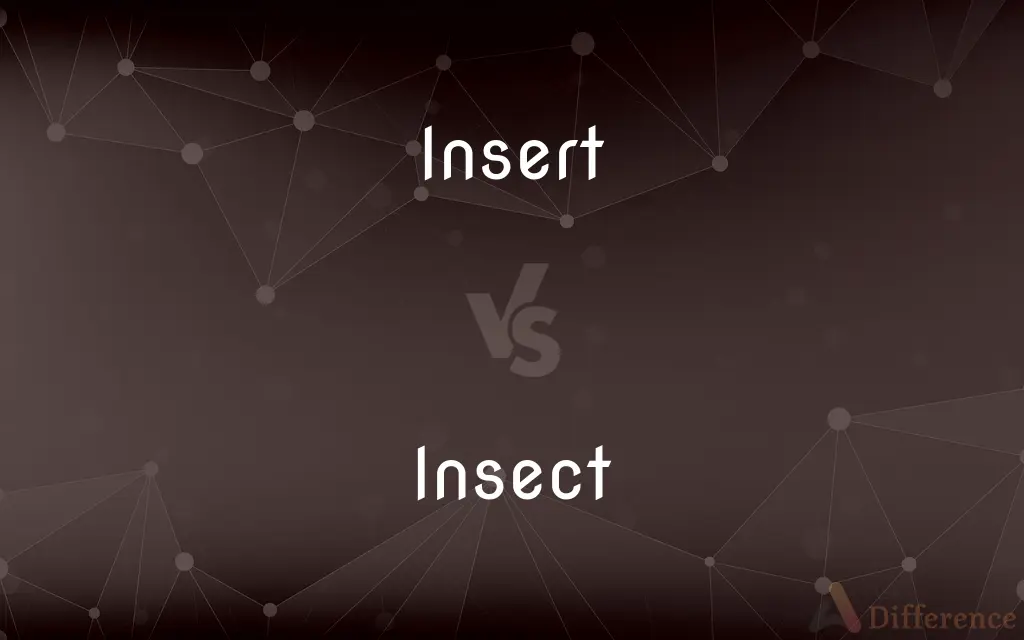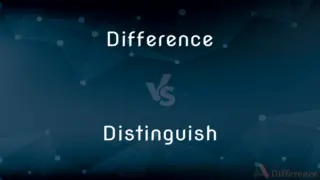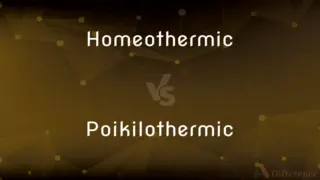Insert vs. Insect — What's the Difference?
By Maham Liaqat & Urooj Arif — Updated on April 17, 2024
Insert involves placing an object into another space or structure, often in a precise manner, while an insect is a small arthropod animal, distinguished by its segmented body and three pairs of legs.

Difference Between Insert and Insect
Table of Contents
ADVERTISEMENT
Key Differences
Insert is the act of putting something into another thing or location, typically with precision and for a specific purpose. Whereas, an insect is a type of arthropod belonging to the class Insecta, characterized by a three-part body plan, including head, thorax, and abdomen.
The verb "insert" is used in contexts ranging from everyday activities like inserting a key into a lock to technical applications like inserting data into a database. On the other hand, insects are studied in fields such as entomology and play critical roles in various ecosystems, including pollination, decomposition, and as a food source for other animals.
Insert typically requires a deliberate action and is often associated with fitting, placing, or adding components in manufacturing, writing, or digital environments. In contrast, insects naturally occur in the environment and are essential for biological and ecological processes.
The concept of insertion can also imply integration or inclusion in broader contexts, such as inserting a clause into a contract. Whereas insects impact environments in less direct but profound ways, such as influencing crop yields and biodiversity.
Insert actions are controlled and can be reversed or modified based on need or outcome, such as removing or adjusting the inserted item. Insects, however, undergo life cycles and transformations that are irreversible, such as metamorphosis from larva to youngs.
ADVERTISEMENT
Comparison Chart
Definition
To place something into another thing
A small arthropod with a segmented body
Context
Manufacturing, writing, technology
Entomology, ecology, biology
Role/Function
Integration, addition, placement
Pollination, food chain, decomposition
Environment
Controlled, artificial
Natural, ecological
Process Characteristics
Reversible, modifiable
Natural cycles, irreversible
Compare with Definitions
Insert
To put into a particular position.
She inserts the key into the lock.
Insect
A creature with a segmented body and jointed limbs.
An insect such as a bee plays a crucial role in pollination.
Insert
To enter data into a system.
Insert your personal information into the form below.
Insect
An individual animal, plant, piece of a mineral, etc., used as an example of its species or type for scientific study or display.
The museum displays insects as specimens for educational purposes.
Insert
To bring in or establish in a new place or environment.
The company plans to insert new policies starting next month.
Insect
An animal that causes plants to make fruit or seeds.
Insects like butterflies and bees are important pollinators in many ecosystems.
Insert
To fix an object firmly and deeply in a surrounding mass.
The surgeon inserts a pacemaker into the patient’s chest.
Insect
An animal or plant detrimental to humans or human concerns.
Locusts are considered pests due to their ability to destroy crops.
Insert
To add or integrate into something else.
The editor decided to insert a new chapter in the book.
Insect
Insects or Insecta (from Latin insectum) are pancrustacean hexapod invertebrates and the largest group within the arthropod phylum. Insects have a chitinous exoskeleton, a three-part body (head, thorax and abdomen), three pairs of jointed legs, compound eyes and one pair of antennae.
Insert
To put or set into, between, or among
Inserted the key in the lock.
Insert a shim between a door jamb and frame.
Insect
A small arthropod animal that has six legs and generally one or two pairs of wings
Insect pests
Insert
To put or introduce into the body of something; interpolate
Insert an illustration into a text.
Insect
Any of various other small, chiefly arthropod animals, such as spiders, centipedes, or ticks, usually having many legs. Not in scientific use.
Insert
To place into an orbit, trajectory, or stream.
Insect
An insignificant or contemptible person.
Insert
To put into action
Inserted a rookie into the lineup.
Insect
An arthropod (in the Insecta class) characterized by six legs, up to four wings, and a chitinous exoskeleton.
Our shed has several insect infestions, including ants, yellowjackets, and wasps.
Insert
Something inserted or intended for insertion, as a picture or chart into written material.
Insect
(colloquial) Any small arthropod similar to an insect, including spiders, centipedes, millipedes, etc.
The swamp is swarming with every sort of insect.
Insert
(transitive) To put in between or into.
In order to withdraw money from a cash machine, you have to insert your debit card.
To make your proof easier to understand, I recommend you insert a few more steps.
Insect
(derogatory) A contemptible or powerless person.
The manager’s assistant was the worst sort of insect.
Insert
An image inserted into text.
Insect
One of the Insecta; esp., one of the Hexapoda. See Insecta.
Insert
A promotional or instructive leaflet inserted into a magazine, newspaper, tape or disk package, etc.
This software can print compact disc inserts if you have the right size of paper.
Insect
Any air-breathing arthropod, as a spider or scorpion.
Insert
A mechanical component inserted into another.
A threaded insert
Insect
Any small crustacean. In a wider sense, the word is often loosely applied to various small invertebrates.
Insert
(linguistics) An expression, such as "please" or an interjection, that may occur at various points in an utterance.
Insect
Fig.: Any small, trivial, or contemptible person or thing.
Insert
(genetics) A sequence of DNA inserted into another DNA molecule.
Insect
Of or pertaining to an insect or insects.
Insert
(television) A pre-recorded segment included as part of a live broadcast.
Insect
Like an insect; small; mean; ephemeral.
Insert
A close-up shot used to draw attention to a particular element of a larger scene.
Insect
Small air-breathing arthropod
Insert
(audio effects) A plug-in that adds an effect to an audio track.
Insect
A person who has a nasty or unethical character undeserving of respect
Insert
(computing) A key to toggle between text insert mode and overwrite mode
Insert
To set within something; to put or thrust in; to introduce; to cause to enter, or be included, or contained; as, to insert a scion in a stock; to insert a letter, word, or passage in a composition; to insert an advertisement in a newspaper.
These words were very weakly inserted where they will be so liable to misconstruction.
Insert
A folded section placed between the leaves of another publication
Insert
An artifact that is inserted or is to be inserted
Insert
(broadcasting) a local announcement inserted into a network program
Insert
(film) a still picture that is inserted and that interrupts the action of a film
Insert
Put or introduce into something;
Insert a picture into the text
Insert
Introduce;
Insert your ticket here
Insert
Fit snugly into;
Insert your ticket into the slot
Tuck your shirtail in
Insert
Insert casually;
She slipped in a reference to her own work
Common Curiosities
Is the action of inserting always physical?
Not always; it can also refer to conceptual actions, like inserting an idea into a discussion.
What are the main characteristics of an insect?
Insects are characterized by a three-part body (head, thorax, abdomen), six legs, and most have wings.
What does it mean to insert something?
Inserting refers to the action of placing or putting something into another thing or location.
What are some common types of insects?
Common types include beetles, flies, bees, and butterflies.
What should be considered when inserting something into a document?
Consider context, relevance, and how the insertion affects the flow and clarity of the document.
How do insects benefit the environment?
Insects play vital roles such as pollination, serving as food for other creatures, and aiding in decomposition.
How is the word 'insert' used in manufacturing?
In manufacturing, 'insert' often refers to the placement of components into a product assembly.
Can the term 'insert' be used in digital contexts?
Yes, 'insert' is commonly used in digital contexts, such as inserting data into a database.
What differentiates insects from other arthropods?
Insects specifically have six legs and often have wings, differentiating them from other arthropods like spiders (which have eight legs).
Why are insects considered pests in many scenarios?
Insects can be pests when their actions negatively impact agriculture, human health, or economic activities.
Share Your Discovery

Previous Comparison
Difference vs. Distinguish
Next Comparison
Homeothermic vs. PoikilothermicAuthor Spotlight
Written by
Maham LiaqatCo-written by
Urooj ArifUrooj is a skilled content writer at Ask Difference, known for her exceptional ability to simplify complex topics into engaging and informative content. With a passion for research and a flair for clear, concise writing, she consistently delivers articles that resonate with our diverse audience.














































